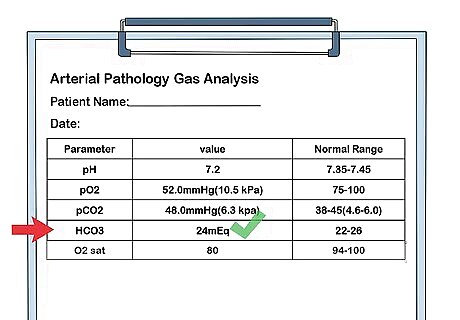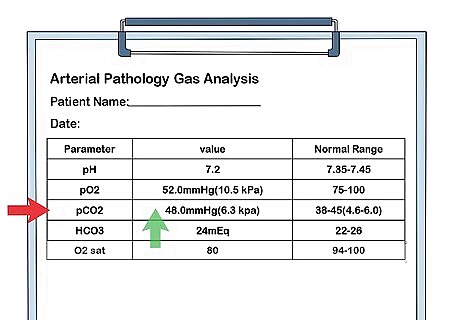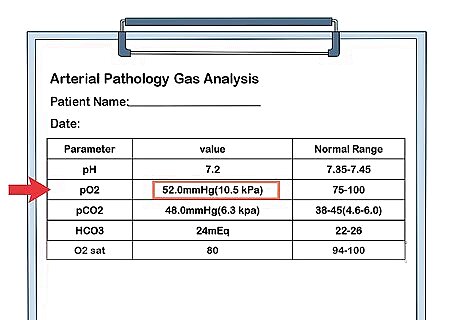
views
Reviewing Your Test Results Closely

Evaluate the results with your doctor. The best way to interpret your blood results is by talking to your doctor. They understand the information and results better than anyone. Making an assessment on your own can lead to misdiagnosis or complications from self-treatment. Ask your doctor any questions you may have about individual or total levels and what they may indicate. Have your doctor go through each series of numbers individually, explaining what they test for and what your specific results may mean. Ask your doctor to compare previous results with the new ones to better judge where you are physically.

Look at the pH number. This measures the number of hydrogen ions in your blood, which may indicate conditions such as COPD, asthma, pregnancy, diabetic ketoacidosis (DKA), lung disease, liver disease, or drug use. The normal range for pH values are between 7.35 to 7.45. If the pH level is below 7.38, then you may have more acidic blood from conditions such as airway obstruction, COPD, asthma, sleep disordered breathing, or neuromuscular impairment. If the pH level is above 7.45, you may have a alkalosis, which could indicate stimulation of the central nervous system, lung disease, severe anemia, drug use, or pregnancy.

Check bicarbonate, or HCO3, numbers. Your kidneys produce bicarbonate and help maintain a normal pH. The normal level for bicarbonate is between 22 to 26 milliEquivalents Per Liter (mEq/L). A disruption of your bicarbonate levels may indicate conditions such as respiratory failure, anorexia, and liver failure. An HCO3 level is below 24 mEq/L indicates metabolic acidosis. It may be the result of conditions including diarrhea, liver failure and kidney disease. An HCO3 level above 26 mEq/L indicates metabolic alkalosis. This may be the result of dehydration, vomiting, and anorexia.

Examine the PaCO2 number. Partial pressure of carbon dioxide, or PaCO2, measures the carbon dioxide in your blood. The normal level for PaCO2 is between 38 and 45 mmHg. Disrupted levels may indicate shock, kidney failure, or chronic vomiting. Respiratory alkalosis is present if the PaCO2 number is below 35 mmHg. This means there is too little carbon dioxide in the blood. It can signal kidney failure, shock, diabetic ketoacidosis, hyperventilation, pain, or anxiety. Respiratory acidosis is present if the PaCO2 number is above 45 mmHg. This means that there is too much carbon dioxide in the blood. This can be a sign of chronic vomiting, low blood potassium, COPD, or pneumonia.

Inspect the PaO2 number. Partial pressure of oxygen, or PaO2, measures how well oxygen can flow from your lungs into your blood. The normal level is between 75 to 100 mmHg. Higher or lower levels may indicate conditions such as anemia, carbon monoxide poisoning, or sickle cell disease.

Notice oxygen saturation. How well your hemoglobin carries oxygen to your red blood cells is called oxygen saturation. The normal levels are between 94 and 100%. Lower saturation rates may indicate the following: Anemia Asthma Congenital heart defects COPD or emphysema Strained abdominal muscles Collapsed lung Pulmonary edema or embolism Sleep apnea
Considering Other Data

Figure in medications or drugs. Certain factors such as your health, medication you take, and where you live can affect the results of your blood gas test. If you are taking any of the following medications or drugs, recognize that they may disrupt your blood gas results: Blood thinners, including aspirin Illicit drugs Tobacco or secondhand smoke Tetracycline (antibiotics) Steroids Diuretics

Recognize your location. The amount of oxygen in the air decreases with elevation, which can also affect your blood gas results. If you live at altitudes of 3,000 feet (900 meters) or higher, factor this in your test. Ask your doctor to correlate your partial pressure of oxygen with your location or factor that a healthy level of saturation is 80-90% between 10,000 – 15,000 feet. Respiratory alkalosis is commonly associated with people going to mountainous areas. Hyperventilation is especially likely when ascent is too rapid and there hasn’t been enough time to acclimate.

Acknowledge current medical conditions. Medical conditions ranging from liver failure to a simple fever can affect your blood gas results. Consider these as you review your test or discuss it with your doctor. The following conditions may disrupt normal blood gas levels: Fever Hyperventilation Prior drug overdose Head or neck injury Respiratory disorders such as asthma and COPD Congestive heart failure Kidney failure Diabetes Blood disorders such as hemophilia

Compare earlier tests. If you’ve had previous blood gas tests, review the results from them. This can give you an idea of any discrepancies that may indicate a new condition or improvement of another. Remember to discuss these results with your doctor, too.




















Comments
0 comment